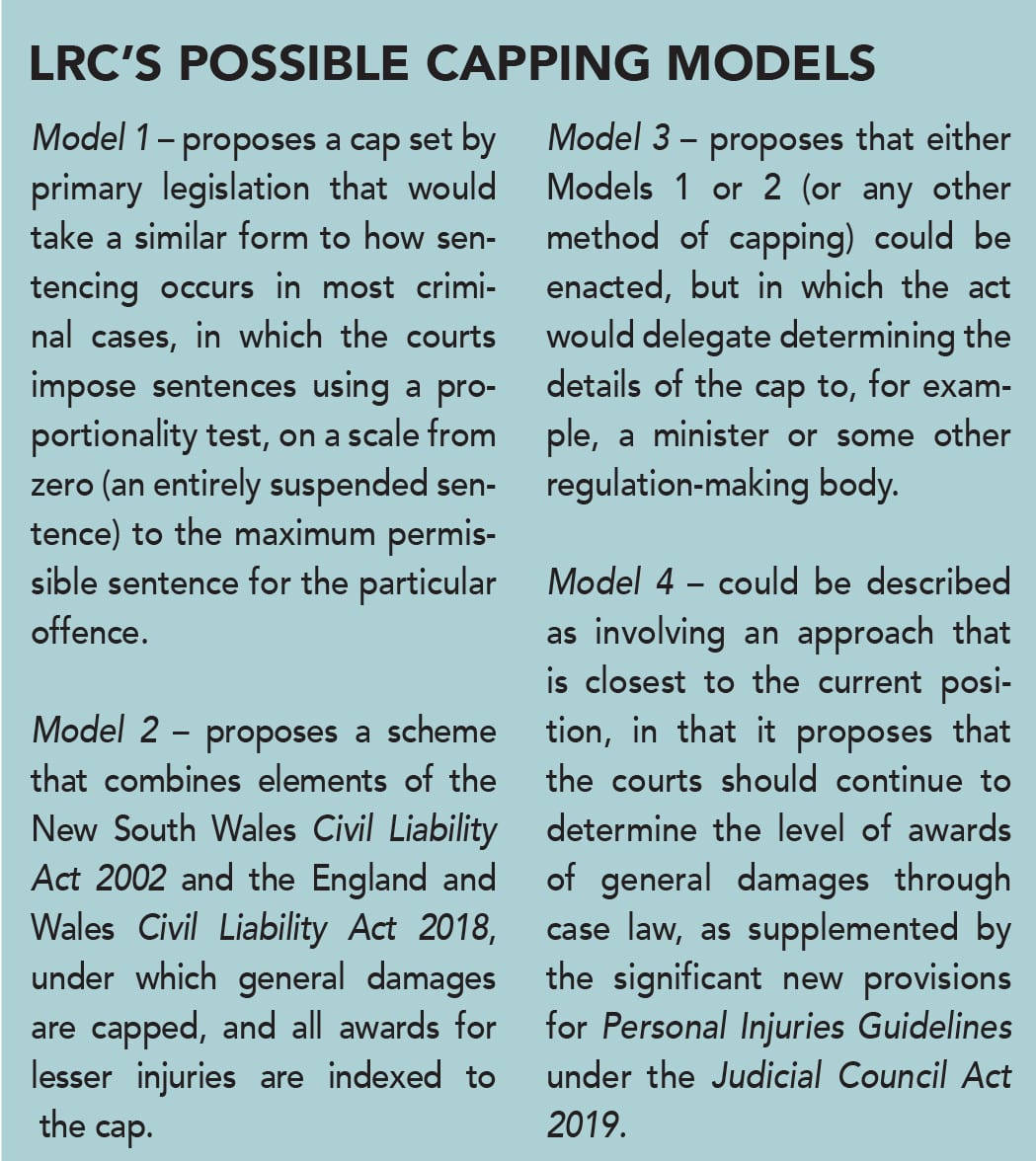The expert constitutional law advice to the Society and the submission’s drafting were provided by former attorney general Paul Gallagher SC, assisted by Catherine Donnelly BL and Francis Kieran BL.

In publishing its paper, the LRC was following a recommendation of the Personal Injuries Commission, which recommended the examination of “whether it would be constitutionally permissible, or otherwise desirable, to provide for a statutory regime that would place a cap or tariff on some or all categories of damages in personal injuries cases”.
Summary
In the executive summary of its submission, the Society provided an overview of its considered position: “The Law Society welcomes the opportunity to respond to the LRC’s wide-ranging and very useful Issues Paper: Capping Damages in Personal Injury Actions, published on 11 December 2019.
“This submission addresses, in detail, the issues raised by that paper. Before addressing the issues raised, the Law Society wishes to draw attention, at the outset, to a number of important matters:
- The paper accepts for the purpose of its legal analysis two factual premises that have not been established by the Government or any relevant body –a) That damage awards are, in fact, too high,
b) That the capping of general damages will result in a lowering of insurance premiums.
- The Law Society would have serious concerns, due to profit maximisation incentives on the part of insurance companies, if damages capping were to be introduced without any consequential reduction in insurance premiums. This is important, having regard to the lack of clarity as to the extent to which the cost of insurance premiums are driven by the profits of insurance companies.
- Having regard to the fact that section 90 of the Judicial Council Act 2019 makes provisions for new guidelines, it would be wholly inappropriate, and not constitutionally justified, to introduce legislative proposals for capping damages without first waiting to see how effective the guidelines introduced pursuant to the 2019 act will be.
“Regarding the four models proposed by the LRC, the Law Society submits that Model 4 be pursued and that the new guidelines introduced pursuant to the 2019 act be given an opportunity to operate.
Separation of powers
“The Law Society is also of the view that Model 4 is the only model that fully respects the constitutional requirements of separation of powers and the constitutional requirement that the administration of justice should be performed by courts.
“Model 4 also satisfies the constitutional requirements set out by Costello J in Heaney v Ireland ([1994] 3 IR 593). As a matter of principle, it would be extraordinary if the legislature, having just introduced Model 4, then decided to ignore it and introduce a different model. As will be explained later in this submission, it is difficult to see how the State could meet the Heaney v Ireland requirements in such circumstances.”
Model 2 alternative
In the alternative, and subject to the above, the Law Society would submit that Model 2 could, in appropriate circumstances, depending on how the cap is devised and on how percentage caps were applied (and subject to proportionality issues), be capable of meeting constitutional requirements.
In addition to the above factors, Model 2 would require to be amended to ensure a proper correlation between the level of severity of injury and the award. However, even if those issues could be addressed, Model 2 would not, in present circumstances, meet the proportionality requirements of Heaney, given the legislative decision to introduce Model 4 and the absence of any evidence that it is inadequate.
The Law Society also takes the view that Model 2 would be more likely to withstand legal challenge than Models 1 and 3.
Not constitutional
The Law Society does not regard Model 1 as constitutional. In its view, Model 1 undermines the constitutional requirements of separation of powers, and that the administration of justice must be conducted by courts.
While the Society accepts that the intensity of the scrutiny applied by the courts to interferences with constitutional rights may be variable, the Society also regards Model 1 – and Model 3 insofar as it envisages a mandatory cap – as not satisfying the Heaney requirements to justify interference with a constitutional right of rational connection between the objective and the means, minimum impairment of the rights, and an overall balance between the interests pursued and the impact on the rights, in particular, given the current state of the evidence on the relationship between the level of damages awards and insurance premiums, and given that an option that has a lesser impact on the relevant constitutional rights is available (that is, Model 4).
Infringe
The Law Society is also concerned that Model 3 would infringe the constitutional principle of separation of powers and the constitutional imperative for the administration of justice by the courts and, at least insofar as it envisages a mandatory cap, it has the same infirmities as Model 1.
Model 3 raises additional problems in the context of article 15 of the Constitution, regarding the delegation of legislative power to another actor, and regarding apparent bias – given that the executive itself can be a defendant in many personal-injuries cases.
Robust
Overall, therefore, the Law Society submits that Model 4 is the most robust model from a constitutional perspective.
Model 2 could, depending on its ultimate formulation, have the potential to satisfy constitutional requirements. Models 1 and 3 should not be considered further.